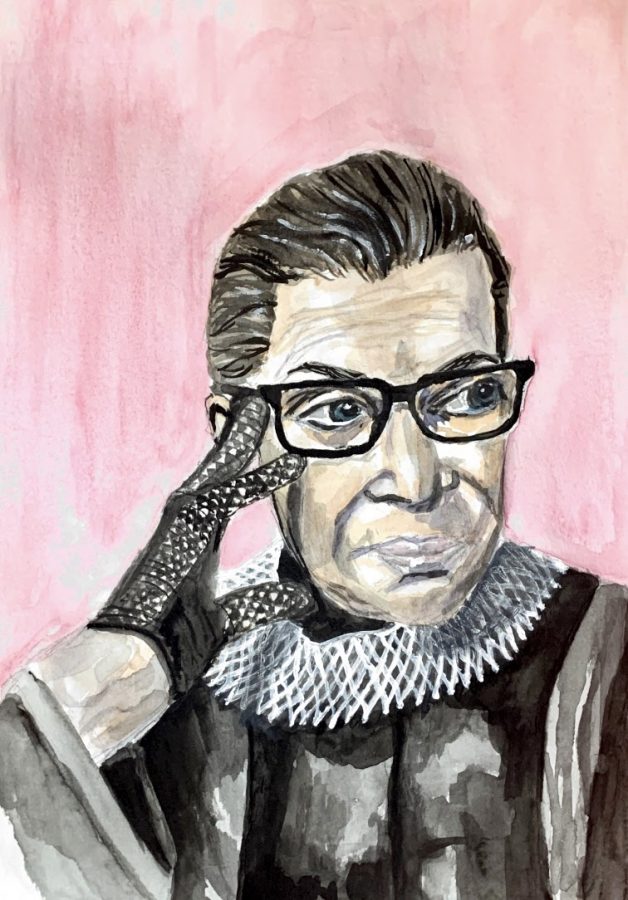What does Ruth Bader Ginsburg’s Supreme Court Vacancy Mean and Where Will the U.S. Go From Here?
The vacancy of the late Ruth Bader Ginsburg, a feminist icon and the second female Supreme Court justice, has led to political controversy as the President seeks to appoint her replacement before the election.
October 7, 2020
Ruth Bader Ginsburg, the second woman to serve on the Supreme Court and widely known to the younger generations as one who transformed society’s gender roles, died on September 18, 2020 after battling pancreatic cancer. A play on the famous rapper, the Notorious B.I.G, Ginsburg was given the name the Notorious R.B.G, as she became an internet sensation and liberal icon in her late life.
Ginsburg’s death means that there is a Supreme Court vacancy only weeks before the presidential election. This has created an atmosphere where mourning and the chaos of replacing her seem to bleed together, as the stakes and tensions are high. President Trump has already appointed two conservative justices to the Supreme Court during his term and Ginsburg’s passing has given him the chance of appointing a third. If Trump is successful in doing so, he would be the first president since Ronald Reagan to appoint three Supreme Court justices and the first to appoint a nominee after the month of July during a presidential election year, according to the New York Times. This would tip the Supreme Court to be highly conservative.
Ruth Bader Ginsburg was a feminist icon and the second female Supreme Court justice. She argued for gender equality, the separation of church and state, and the rights of workers. Ruth Bader Ginsburg famously said: “When I’m sometimes asked ‘When will there be enough [women on the Supreme Court]?’ and my answer is: ‘When there are nine.’ People are shocked. But there’d been nine men, and nobody’s ever raised a question about that.” CNN explains that R.B.G did not retire during Obama’s presidency because she wanted the first female president, hoping it would be Hillary Clinton, to appoint her successor. However, Trump won the election and she passed with only a few months remaining for him to appoint her successor.
With President Trump’s replacing Ginsburg, her seat would be taken by someone who could potentially undo many of the decisions she had pivotal roles in making and are important to many Americans’ lives. Trump’s nomination for the replacement is Amy Coney Barrett, a conservative woman, which would solidify a 6 to 3 conservative majority on the Supreme Court. The Washington Post describes that Barrett is the “ideological opposite of the woman she would replace.”
What makes this scenario even more complicated is that the world is in the midst of a pandemic, and the United States is only weeks away from a presidential election, which has lent itself to much debate over how the vacancy should be filled.
Before Ruth Bader Ginsburg died, she dictated her dying wish to her granddaughter: “My most fervent wish is that I will not be replaced until a new president is installed.”
President Trump claims that he has the job to name her replacement, and as he has been behind Biden in the national polls and in the battleground states, the New York Times describes how this is a way to rally and build up momentum in his supporters. This also gives the people a different avenue to focus on instead of economic challenges and the Coronavirus pandemic that continues to grow in the states.
The New York Times explains how Senate majority leader, Mitch McConnell, says that regardless of what happened in the past, Trump’s nomination for a Supreme Court justice would get a vote on the Senate floor. This is very controversial and has angered many, for in 2016, Republicans would not allow Obama to fill a third supreme court seat after Antonin Scalia had died because it was an election year. The senate would not even consider the nomination, which seems to contradict their viewpoints on Ginsburg’s vacancy because the country is now only weeks out from the presidential election. This time is different, argue Republicans, because they have control of both the Senate and House, so they have the ultimate say. There might not be anything that Democrats can do to stop this process because under the rules of the Senate and Constitution, and because of the way the process works, it is very possible for Trump to fill the vacancy.
Many Republicans also have agreed that it would not be appropriate to consider a Supreme Court nomination this close to an election. However, now we are seeing the aftermath of leaders either sticking to their word, or going back on it and following McConnell’s lead. For example, Senator Lindsey Graham said repeatedly in 2016 that “If there is a Republican president in 2016 and a vacancy occurs in the last year of the first term, you can say, let’s let the next president, whoever it might be, make that nomination. And you could use my words against me. And you’d be absolutely right.” In 2018 he again said, “If an opening comes in the last year of President Trump’s term and the primary process is started, we’ll wait until the next election.” However, the New York Times describes how he immediately disregarded his previous words, and in support of President Trump, said that they should move forward with the nomination.
What does it mean if Trump gets another justice?
Presidential candidate, Joe Biden, argues that if Trump gets re-elected or a conservative nominee, like Amy Coney Barrett, replaces Ruth Bader Ginsburg, citizens can say goodbye to their healthcare as the Trump administration is looking to take away the Affordable Care Act. The Affordable Care Act, or Obamacare, has expanded access to health insurance for many Americans, but it is constantly being challenged in the court. CNN states that a conservative majority could easily overturn the law. In the past, it only survived because conservative Chief Justice John Roberts sided with his liberal counterparts. As of now, Republicans and the Trump Administration have no plan of replacing it, which would leave many Americans without access to health insurance coverage.
Another worrisome component for many Democrats is the landmark ruling in the US in 1973 of Roe v. Wade which legalized abortion. With a conservative replacing Ginsburg, there are high chances that abortion can, and will, be outlawed or restricted in many US states.
The vacancy of a liberal justice has produced immense stress and tensions and pushed the Democratic left to become more engaged in the Supreme Court than before, according to the New York Times. People are becoming more aware, and more concerned, about the future of the country. R.B.G’s death amidst the pandemic and social unrest in the US was the tragic alarm that woke many up to the broken process.


